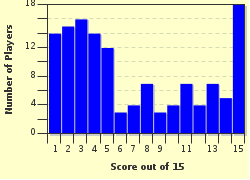Quiz Answer Key and Fun Facts
1. The modern Japanese are believed to be descended from a mixture of the prehistoric inhabitants of the islands and the Yayoi people, who began to migrate from mainland Asia around 500BC, inaugurating the Yayoi Period. What is the name given to the period preceding the Yayoi, when Japan was inhabited solely by those prehistoric indigenous groups?
2. The earliest evidence of a unified political entity in Japan comes from the records of the Chinese Wei Dynasty in the third century AD. They described a federation of thirty tribes which fought against the surrounding tribes and sent ambassadors to China. What did the Wei call this confederation?
3. By historic times, Japan was ruled by a unified political entity - the Yamato state. By this time, the center of power had moved from Kyûshû to Honshû, where the Yamato people had settled the two great plains still known as the Kansai and Kantô. What does the 'Kan' in these two words mean?
4. The Yamato state was ruled by the Imperial family of Japan, which has survived to the present day. From early times, however, the Emperors were dominated by great aristocratic clans. The sixth century saw the great rivalry between the Soga and Mononobe clans, who were bitterly opposed to each other because of what kind of issue?
5. What are the names of the first two schools of native Japanese Buddhism, founded respectively by two monks who traveled to China on the same government-sponsored study mission in 804?
6. What is the name of the great aristocratic clan that dominated the court during the Heian Period (794-1185)?
7. The writings of aristocratic women during the Heian Period are considered to have much greater literary merit than those of men. What is the reason for this?
8. During the middle and late Heian Period, powerful aristocrats who had been given territories in the provinces began to put themselves at the head of a new class of people in Japanese society - the samurai. What kind of people were the samurai originally?
9. In the last years of the Heian Period, as power in Japan passed from the court nobility to the samurai, which two great warrior clans fought for supremacy?
10. The conflict ended in 1185 with the battle of Dan no Ura, and the death of the Emperor Antoku. How did he die?
11. The new samurai rulers of Japan called their government a 'Bakufu', or 'Shôgunate'. Formally established in 1192, it is known to history as the [fill in the blank] Bakufu.
12. During the period of this first Bakufu, many new native schools of Buddhism emerged. Which school, established in the last years of the Heian Period, has a name that translates as 'Pure Land'?
13. Japan was fortunate that the Mongol invasions of the late thirteenth century came during the relatively brief period in which she had a strong, unified military government. Which modern-day Japanese city is the site of the two Mongol landings?
14. Which Emperor plunged the country into civil war in the early fourteenth century, by announcing that he would rule personally, without the Bakufu?
15. In 1333, the Bakufu was overthrown, and the Emperor was 'restored'. The warrior who achieved this victory was Nitta Yoshisada, one of two great generals in the Imperial camp. The other general, in the years to come, would defeat both Nitta and the Emperor, and found a new Bakufu ruled by his own clan, the Ashikaga. What was his name?
Source: Author
Finduskeepus
This quiz was reviewed by FunTrivia editor
bloomsby before going online.
Any errors found in FunTrivia content are routinely corrected through our feedback system.


